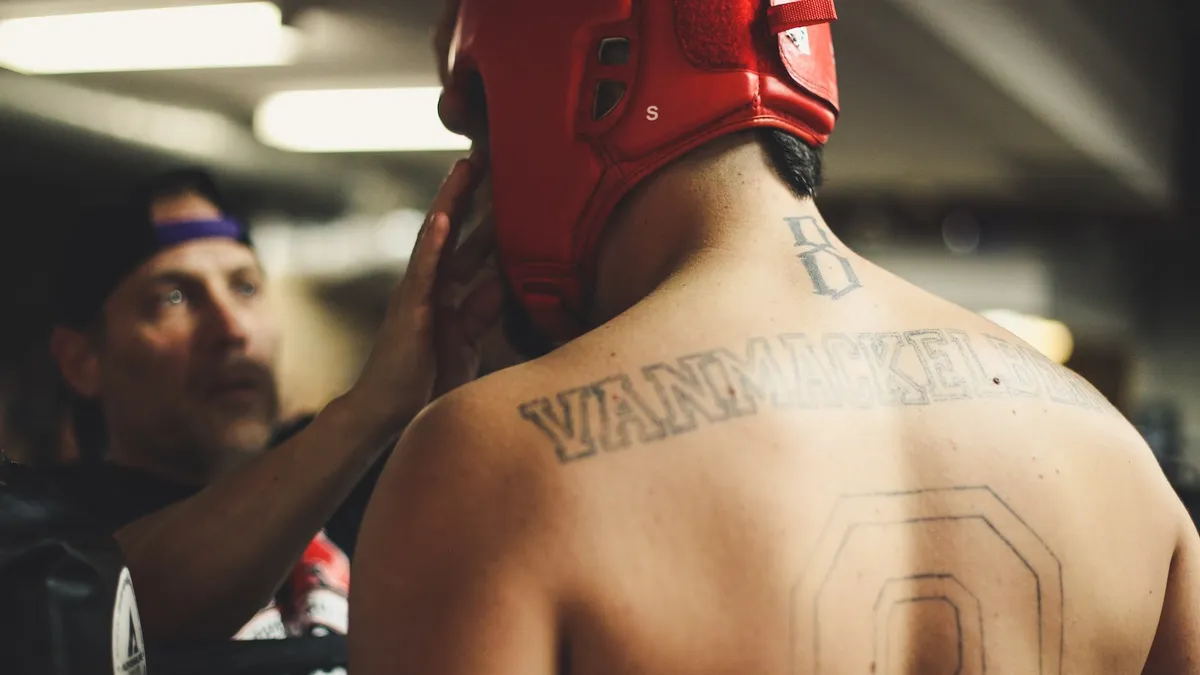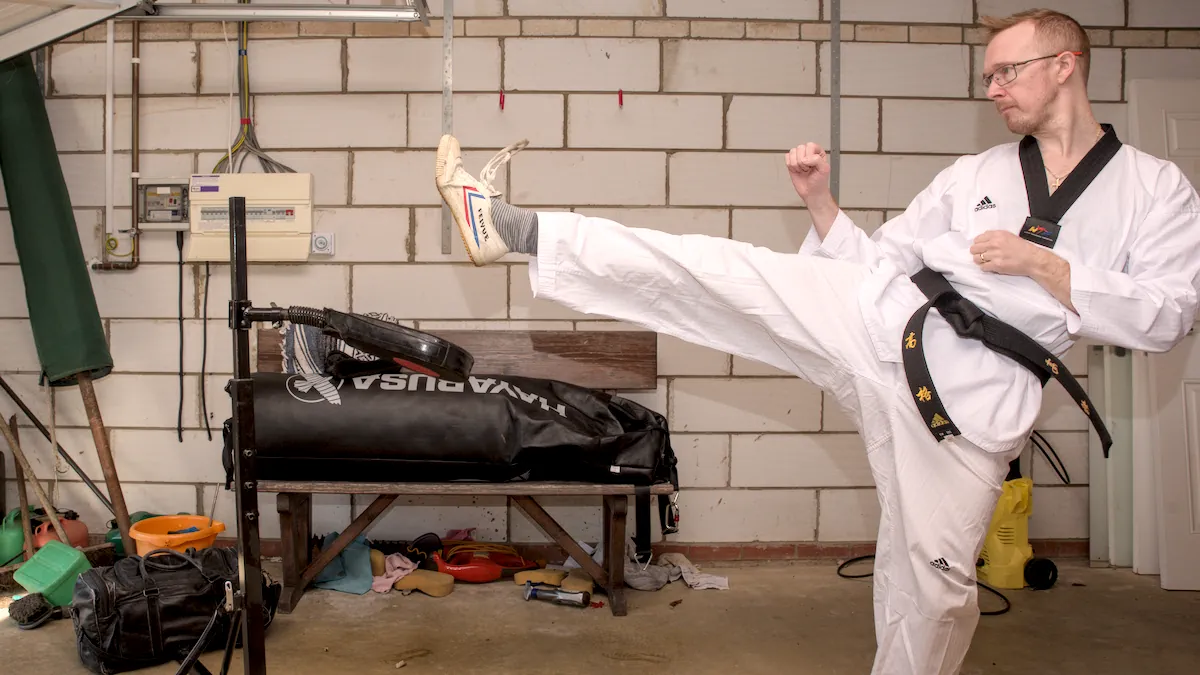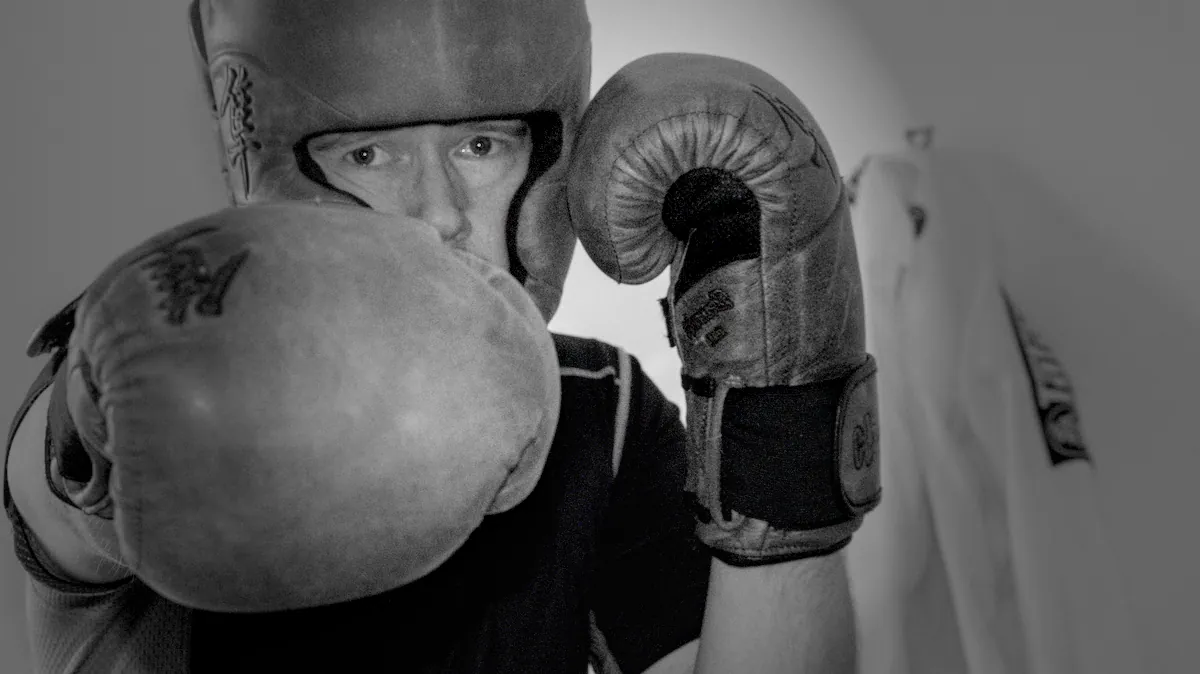I started learning martial arts when I was six years old, and since then, I’ve trained every type of martial art you can imagine. I’ve trained Muay Thai in Thailand and even moved to China to study with Shaolin monks and other kung fu masters. This experience has given me the perfect perspective to help you answer the question, “What martial art should I learn?”
Answer These Questions Before Choosing Which Martial Art to Learn
How Athletic Are You?
The first thing you should consider before choosing a martial art is how fit you are and your athletic potential. Fitness level will play a massive part in success in some martial arts and very little in others.
The three most important factors will be:
- Strength
- Flexibility
- Cardio
Different martial arts rely on various aspects of fitness. For example, strength is essential to styles like wrestling but doesn’t play such a significant factor in a style such as taekwondo.
If you can’t bend forward without tight, painful hamstrings, taekwondo will be a struggle for you.
And if you get out of breath just taking a slow walk, doing muay thai is probably off the table (for now.)
Of course, any decent martial arts program will teach you the skills you need to progress and be successful, but you should be realistic with yourself. For example, if you’re in your forties, have never worked out, and have a bad back, you’re unlikely to make much progress in a martial art that requires flips and spins like wushu.
On the other hand, if you’re out of shape but only in your early twenties and are willing to train hard, you can push yourself a little harder. Find a training program for martial arts and get started getting in shape!
What Do You Want to Learn For?
There are many reasons to learn martial arts; everyone has different goals and different personalities, so their choice of which martial art to choose will be different. You might decide to learn martial arts because you want to:
- Lose weight
- Improve your health
- Learn to defend yourself
- Compete
- Get more confident
- Be the next Bruce Lee
- Look more masculine
Each martial art style brings different strengths and weaknesses, traditions, and training methods; some will align with your goals better than others. So, first, knowing why you want to learn is vital when picking a martial art; then, you can see which martial art below fits your goal.
How Much Time Do You Have To Dedicate To Martial Art Training?
The amount of time you’re willing to spend training each week should be in line with your reason for training above. For example, if you just want to lose weight, training once a week probably won’t have much impact, and if you’re going to compete and become a champion, you will need to train every day.
How much time do you have? And how much are you willing to spend training? Not only in class but at home too. For most of my teens, I went to class three or four times each week; on weekends, I would spend the whole day with my teacher, often working around his farm between training sessions.
We’d wake up to do qigong and tai chi, then spend the day training weapons, tao lu, and san da kickboxing in his fields.
Every evening at home, I’d stretch out and spend a couple of hours working on some aspect of my training. I had a heavy bag hanging in the garden, a wall bag in the garage, and a pole dug into my yard to toughen my shins.
But you don’t have to train every day; you just have to train enough to accomplish your goal.
How to Chose a Martial Art
I don’t think you should choose a martial art based on how you think you’ll fight best.
Of course, you want to be successful and maximize your natural talents, but there is something more important when picking a martial art to start learning.
You might occasionally enter competitions to test your skills, and hopefully, you never have to use them in real life. Learning martial arts isn’t really about fighting because you don’t actually do much fighting; it’s much more about training.
If you learn as a hobby, expect to train twice a week; if you get a little more serious, you might train every day. Either way, most of your time will be spent training, not fighting.
So pick a martial art based on the training, not the fighting.
Standing & Striking vs. Grappling and Groundwork
Two of the most popular martial arts now are muay thai and jiu-jitsu; they are both highly developed and useful in the ring and on the street. Their effectiveness in the MMA cage and the many UFC fighters who utilize them have catapulted them into the spotlight.
Compare the way you train for these two martial arts.
Muay Thai
- Running
- Hitting pads
- Hitting Heavy Bags
- Kicking
- Sparring (standup)
Jiu Jitsu
- Ground movement drills
- Fighting for position
- Practicing escapes and submissions
- Sparring (ground)
Learning muay thai, you won’t spend much time chest to chest or in contact with anyone, so if you are an introvert or omnivert, it may appeal more to you.
But learning jiu-jitsu, you will be on top or under someone almost all the time, sweating on each other and rolling around. This might not sound like the way you want to spend 5 hours each week.
- Do you want to stand and strike or grapple on the floor? Or Both?
Hands vs. Feet
When I was a kid, taekwondo was the most popular martial art around; the 1988 Seoul Olympics and its new status as an Olympic sport made taekwondo explode in popularity.
Although it’s no longer the martial art of choice, it still makes a good point.
An average taekwondo class starts with a warm-up and then some stretching, concentrating on the hamstrings because taekwondo is almost all kicks. If you have tight hamstrings, stiff joints, or just don’t want to wave your legs around every class, taekwondo, or any style with lots of kicking, will be torturous to learn.
Boxing, on the other hand, is all punching, sure there are evasive movements too, but still, it’s pretty one-dimensional. But, as a sport, boxing is popular, so you can always find a club, and there’s big money to be made by going pro. And in terms of combat, boxing gives you real skills quite quickly.
But in terms of training, it can be pretty repetitive. No kicks, no grappling, no throws, no elbows, no knees, no submissions. It might be perfect if you’re looking for a hobby for someone in their 30s or 40s, but if you want to be the next Bruce Lee, you’ll need something more.
- Do you want to mostly use your hands or feet or both? How flexible are you?
Take a look at the most popular martial arts below and see which training method fits best with your answers.
Aikido
Aikido is a controversial martial art. Originally from Japan, there have been many martial arts experts who come out and say that many of its most famous techniques won’t work on an unwilling opponent. For example, demonstrations of old men able to throw around fully grown black belts at will, yeah, that doesn’t really happen in the real world. Still, it could be a good hobby for your resume.

- Country of Origin: Japan
- Primary Fighting Method: Standing, locks, and throws
- Notable Practitioner: Steven Seagal
- Suitable For: Most with a medium fitness level. It has been shown to be ineffective for self-defense and competition.
Karate
Karate is a Japanese martial art based on white crane kung fu and has been popular in the West since the 60s. Karate competitions are easy to find, as are karate clubs, although many mcdojos exist with the sole aim of churning out black belts and making money. So try to find a teacher with a good background from a recognized karate organization.
- Country of Origin: Japan
- Primary Fighting Method: Standing, striking with hands and feet
- Notable Practitioner: Chuck Norris
- Suitable For: Most with at least a low-moderate fitness level.

Judo
Judo is an Olympic sport best known for its throws. If you like the idea of rag-dolling someone and being able to toss them about, Judo might be the martial art of choice for you. Originally from Japan, you can find judo clubs all over.

- Country of Origin: Japan
- Primary Fighting Method: Standing and Ground, Throws and submissions
- Notable Practitioner: Ronda Rousey
- Suitable For: Most with moderate fitness levels.
Jiu-Jitsu
Originally from Japan, jiu-jitsu gained notoriety after Julio Gracie learned and improved many of the techniques of traditional jiu-jitsu, creating BJJ, or Brazilian Jiu-Jitsu. Later Royce Gracie used his Father’s style of jiu-jitsu to become the first UFC champion, proving that size and strength could be overcome with correct technique. Chose this style if you’re a sigma male who doesn’t like the idea of getting hit and prefer learning complex movements and stringing them together creatively.
- Country of Origin: Japan
- Primary Fighting Method: Ground, submissions
- Notable Practitioner: Royce Gracie
- Suitable For: Most with moderate fitness level

Taekwondo
Taekwondo is the martial art you should chose if you want to learn high kick, spins and all the flashy kicks you’ve seen in your favorite fight scenes. Although not the most effective fighting style, taekwondo competitions are common at all levels up to the Olympic level. Tae kwon do is a great hobby for men in their 20s.

- Country of Origin: Korea
- Primary Fighting Method: Standing, Kicks
- Notable Practitioner: Anthony Pettis
- Suitable For: Most with moderate fitness level
Tang Soo Do
Tang Soo Do, is a second Korean martial art developed alongside taekwondo. Somewhere between taekwondo and karate, tang soo do is less common, so you might find it easier to just find a taekwondo or karate class. But if you find a class near you and your kids want to try it out, take them along and see what they think.
- Country of Origin: Korea
- Primary Fighting Method: Standing, Kicks
- Notable Practitioner:
- Suitable For: Most with moderate fitness level

Shaolin Kung Fu
When the Shaolin monks toured in the late 90s I knew I wanted to train with them and I was lucky to train both at the Shaolin Temple in London (before they bought the current premises) and later in the actual Shaolin Temple in Henan, China. Although much of the traditional shaolin arts are no longer with us, the spirit of Shaolin is something that you always take with you after training with he warrior monks. Running up Song Mountain in the morning sun before breakfast and before the real training begins makes the average martial art class back home seem like a walk in the park.

- Country of Origin: China
- Primary Fighting Method: Standing, striking with hands and feet
- Notable Practitioner: Shi Yanzi (London Shaolin Temple)
- Suitable For: Those with a high fitness level
Wing Chun Kung Fu
Wing Chun is the martial art that Bruce Lee learned before he became the first Chinese superstar. It’s a close-range, southern Chinese style that mostly focuses on short, sharp hand strikes. Created by a woman, this short-range style has often been ineffective inside the MMA ring, but many practitioners maintain that it shines outside of the ring and in the street.
- Country of Origin: China
- Primary Fighting Method: Standing, striking with hands
- Notable Practitioner: Yip Man
- Suitable For: Most with low fitness level

Wushu
There is a little confusion over the term”wushu” and understandably so. As someone who did on occasion train with the British national wushu squad under Master They in Southampton and as a fluent Chinese speaker, let me clear it up once and for all.
- Wushu means “martial art” in Chinese, and they use it as we do.
- In martial arts circles in the West, however, “wushu” means the modern performance style of Chinese Kung Fu

- Country of Origin: China
- Primary Fighting Method: Standing, performance with hands and feet
- Notable Practitioner:
- Suitable For: Those with a high fitness level
Kickboxing & Sanda
I’ve put kickboxing and Sanda together here, although they are different. As a teenager, I trained Sanda, but as competitions were not common due to the lack of Sanda clubs, we would enter kickboxing competitions. Any style of kickboxing will be an effective martial art style to learn. With the focus on sparring and competition, you get plenty of opportunities to test out your skills.
- Country of Origin: China
- Primary Fighting Method: Standing, striking with hands and feet
- Notable Practitioner:
- Suitable For: Those with moderate-high fitness level

Muay Thai
Muay Thai is the flavor of kickboxing found in Thailand. It has some differences from other forms of kickboxing, with an emphasis on low kicks to the legs and the use of knees and elbows. Most MMA gyms offer muay Thai as an option to gain strong stand-up skills as it shows itself time and again to be effective in the ring.

- Country of Origin: Thailand
- Primary Fighting Method: Standing, striking with hands and feet
- Notable Practitioner: Buakaw Banchamek
- Suitable For: Those with moderate-high fitness level
Wrestling
Wrestling is popular in many countries. From sumo wrestling in Japan to Greko-Roman and Mongolian wrestling, but the type you are most common to find is American-style wrestling found in most high schools. Wrestling gives you a huge advantage in a fight as you get to decide where the fight takes place; at range, close, or on the floor. It’s an essential skill for anyone competing in MMA competitions.
- Country of Origin: Many
- Primary Fighting Method: Standing and ground, grappling
- Notable Practitioner:
- Suitable For: Those with moderate-high fitness level

Boxing
Despite the popularity of the UFC and mixed Martial Arts, boxing is still the most popular and well-paid pugilistic sport out there. So much so that UFC champions will take boxing matches even if they are highly outmatched for the huge purses. Connor Mcgregor reportedly took home $100 million after his fight with Floyd Mayweather. Everyone’s seen Rocky, so you know what to expect when you step into a boxing gym.

- Country of Origin: Many
- Primary Fighting Method: Standing, striking with hands
- Notable Practitioner: Mike Tyson
- Suitable For: Most with moderate fitness level
Tai Chi
People train tai chi in vastly different ways; if you want a gentle form of exercise suitable for older people or rehabilitation, find a Yang-style class, it’s a great hobby to do indoors or outdoors. On the other hand, if you want to train tai chi (or taiji) as a real martial art, look for someone teaching Chen style. When you strip away all the flowery language and talk of magical energy, tai chi is a wrestling style. I would often come home with bruised wrists, exhausted after training in Beijing. It’s a tough workout.
- Country of Origin: China
- Primary Fighting Method: Standing, grappling
- Notable Practitioner: Chen Fa Ke
- Suitable For: Anyone, regardless of fitness level

Capoeira
Capoeira is a fighting style hidden within a dance. Originally practiced by Slaves from Africa who needed to disguise what they were doing, it maintains lots of interesting cultural apects, such as music playing with the Berimbau and singing. Capoeira is a great style to learn if you like to dance and want to learn some cool-looking spins and acrobatics.

- Country of Origin: Brazil
- Primary Fighting Method: Standing, striking with feet
- Notable Practitioner:
- Suitable For: Those with a high fitness level
MMA
Much like Bruce Lee’s Jeet Kune Do, “the way of the intercepting fist,” (which is actually a technique from Wing Chun,) MMA isn’t really a style. It’s the idea that you should find the best parts of other styles and train what works best for you. If you’re serious in achieving the best martial arts skill you can, MMA will get you there. As Bruce Lee said, “Baby you better train every part of your body!”
- Country of Origin: USA
- Primary Fighting Method: All
- Notable Practitioner: Bruce Lee
- Suitable For: Those with a high fitness level

Final Thoughts
Still not sure which to pick? Don’t think about it too much, just go with whatever style appeals to you most. Remember you can always switch to something else if you don’t enjoy it. So try a few classes and kick some butt!






